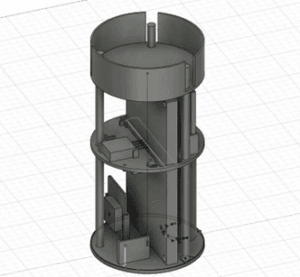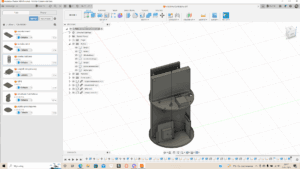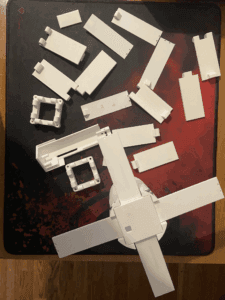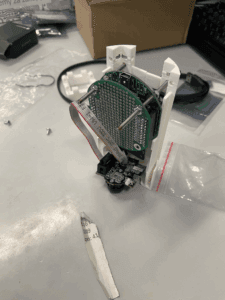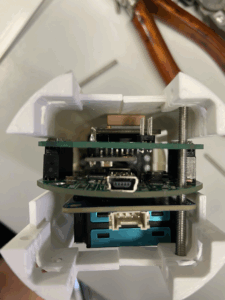Mission objective and functions of the mini-satellite
As the main objective of our CanSat mission, we chose to test and measure conditions on foreign planets, due to our interest in astronomy and space exploration with a view to expanding human reach to other planets and establishing research centers on them.
This includes making sure that a given planet is safe to land on—we will measure elements of its living conditions, such as temperature, pressure, electromagnetic field, and humidity. To ensure that not only the equipment is safe, but also people, we will measure more detailed parameters such as gamma radiation, UV radiation, and light intensity, the latter mainly to predict the efficiency of solar panels. In addition, we will make sure that our CanSat survives a fall from the height specified in the challenge, for which we will install an accelerometer, GPS, and gyroscope.
All collected data on the measured parameters should be stored on an external memory device, in this case a microSD card, and transmitted in real time during the descent to the ground station via radio transmission.
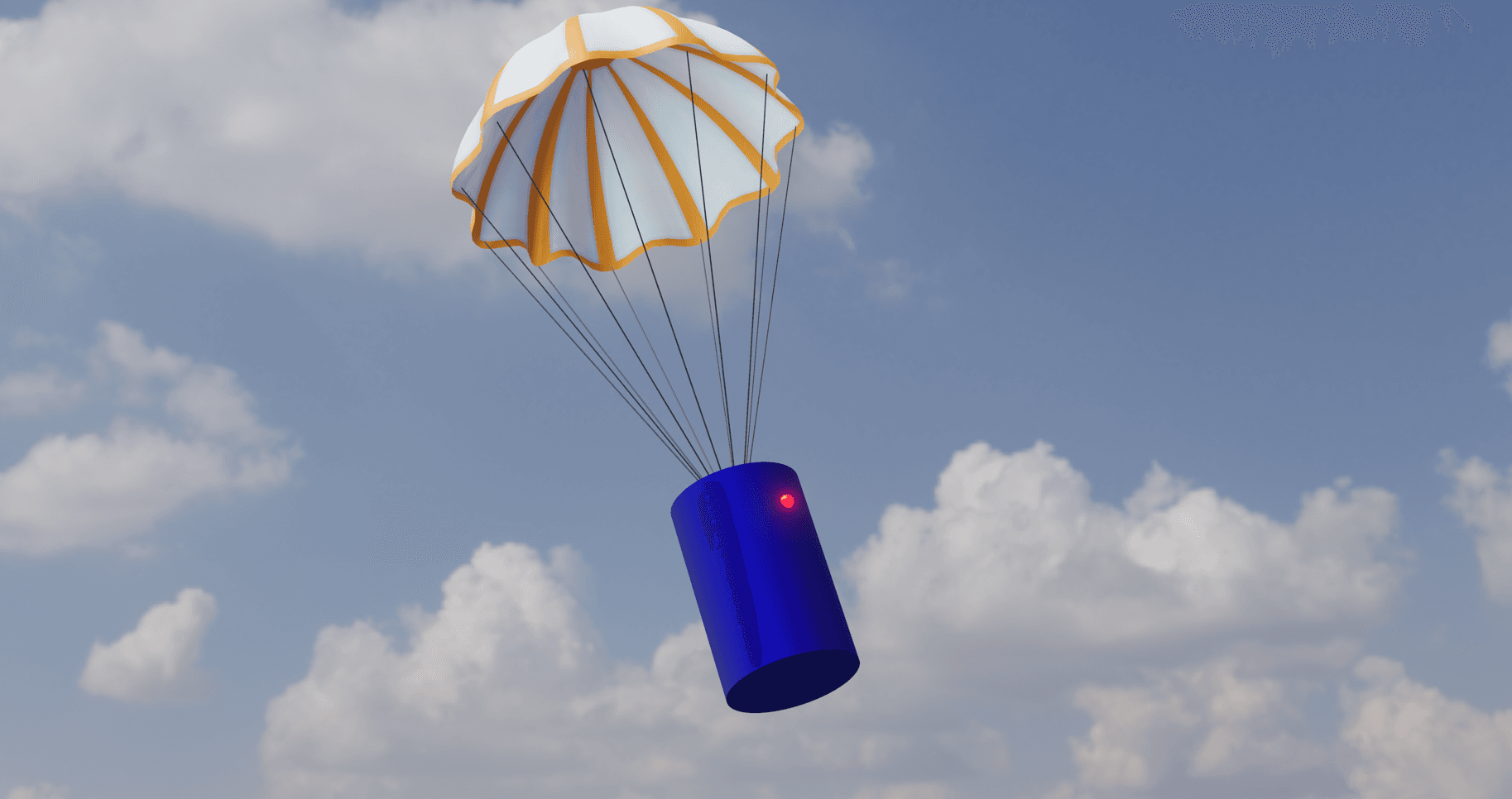
Mini-probe design
Overview
The probe will be dropped from a rocket launched to an altitude of approximately 2,000 meters, and its descent speed will not exceed 8 meters per second. During descent and after landing, our probe will continuously measure all the parameters listed above.
Mechanical design
All modules and systems that will comprise the probe are:
- Sensor module: such as a thermometer (DHT11), hygrometer (DHT11), barometer (IMU 10DoF), magnetometer (IMU 10DoF), GPS (MTK3339), Geiger counter (GC-1602-NANO), and spectrophotometer (AS7265x). To determine whether the alien planet is a safe area for colonization, gamma radiation, UV radiation, and electromagnetic fields will be measured. In addition, light intensity will be checked to indicate whether the solar panels of the future colony will be effective. Any other measurements from the secondary mission will be used to determine the current position and status of our probe, in accordance with the planned course of the mission.
- Case: 3D printed using PETG filament, weighing just over 300 g. The opening part of the casing will probably be located at the bottom of the CanSat to provide easy access to the battery and equipment. To make the spectrophotometer work, we will make a round hole on one side of the satellite's housing. We will also install LED indicator lights and an on/off switch on its outer surface. Most of our satellite's modules will be mounted vertically, with the heaviest components, such as the battery, at the bottom of the housing.
- Główny kontroler: Arduino Nano RP2040 działa jako główny kontroler i płyta główna naszego satelity. Zawiera on mikrokontroler Raspberry Pi RP2040. Każdy moduł używany w misji podstawowej i dodatkowej będzie do niego podłączony, a kontroler będzie odpowiedzialny za transmisję danych między mini-satelitą a stacją naziemną, również za pośrednictwem modułu radiowego.
- Moduł zapisu danych: czytnik kart microSD zostanie zainstalowany na zewnętrznej powierzchni obudowy.
- System komunikacji (moduł radiowy): jednokierunkowy (tylko z naszego CanSata do stacji naziemnej), o częstotliwości radiowej 433 MHz. Użyjemy modułu LoRa-02 jako nadajnika-odbiornika, ze zwykłą anteną miedzianą 33×4,9 mm w satelicie i anteną COMA ATK-10 podłączoną do stacji naziemnej.
- Moduł zasilania: zasilanie przebiegnie dzięki akumulatorowi litowo-jonowemu o pojemności 3350 mAh. Według odczytów zużycia energii podczas pracy każdego modułu, nasz satelita CanSat powinien działać przez około 7,5 godziny, przy średnim zużyciu — około 10 godzin.
- System odzyskiwania z modułem GPS: spadochron jest częścią główną systemu odzyskiwania naszego CanSata. Głównym celem jego wykorzystania jest spowolnienie opadania CanSata do 8 m/s. Spadochron będzie miał kształt kopuły i będzie wykonany z nylonu, z użyciem jaskrawoczerwonych materiałów, w celu późniejszej lokalizacji sondy CanSat w miejscu lądowania na ziemi. W procesie lokalizacji potrzebny jest GPS, z ktrego sygnał będzie wysyłany w sposób ciągły do momentu odnalezienia i wyłączenia satelity.
Software design
Zadaniem oprogramowania dla naszej mini-sondy będzie obliczanie odpowiednich wartości przy użyciu danych pomiarowych uzyskanych z głównego i dodatkowego modułu misji i wysyłanie ich do stacji naziemnej. Powinno ono zarządzać systemem komunikacyjnym tak, aby priorytetowo wysyłać najważniejsze informacje, takie jak lokalizacja i prędkość. Drugą istotną funkcją programu sterującego satelitą będzie zapisywanie mierzonych danych bezpośrednio na dysku zewnętrznym podczas procesu pomiarowego. Większość zebranych danych zostanie przesłana w systemie bieżącym do stacji naziemnej, ale aby nic z nich nie zostało utracone, kopia każdego wyniku pomiaru będzie przechowywana.
Opisane oprogramowanie zostanie napisane w Arduino C, w środowisku programistycznym Arduino IDE.
Stacja kontroli naziemnej
Nasza stacja naziemna będzie składać się z jednego komputera podłączonego do modułu zarządzania radiowego, który przechwytywać ma dane odbierane z mini-satelity. Oprogramowanie stacji naziemnej wyświetli każdy otrzymany wynik pomiaru w aplikacji w postaci odpowiadających wykresów. Nasz model CanSat 3D wskaże wszystkie informacje o pozycji satelity i jego statusie. W ten sam sposób dane będą wyświetlane w ogólnodostępnej aplikacji mobilnej. Dane wykorzystywane przez aplikację mobilną będą dostarczane za pośrednictwem internetowego serwera FTP przez komputer stacji naziemnej. Oprogramowanie stacji naziemnej zostanie napisane głównie w języku programowania C#, z wyjątkiem modułu zarządzania radiem napisanego w Arduino C.
